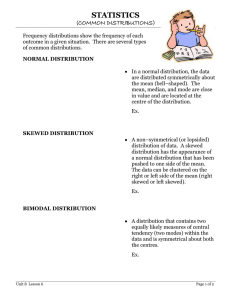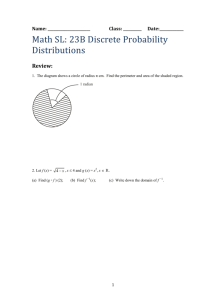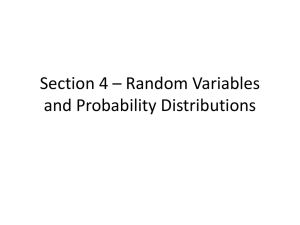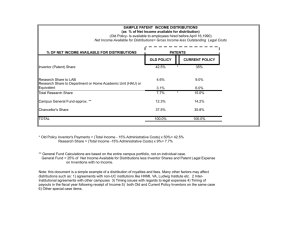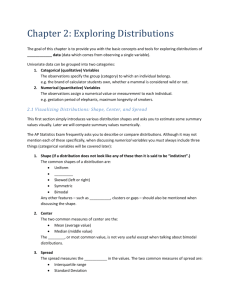MDM4U Continuous Probability Distributions
advertisement
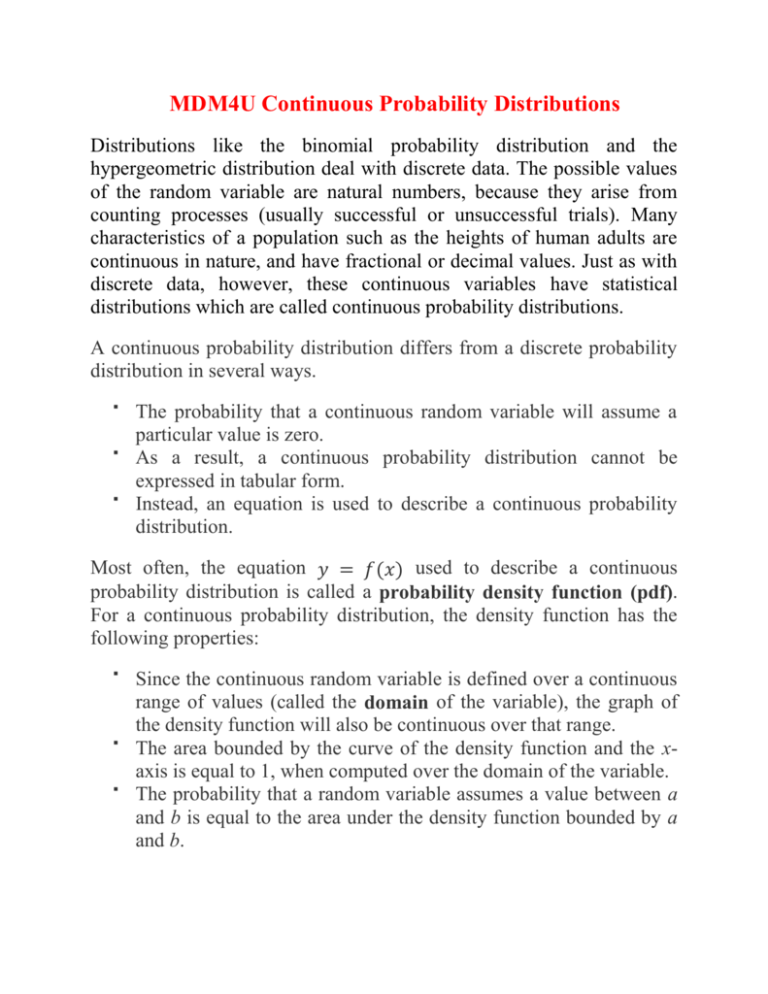
MDM4U Continuous Probability Distributions Distributions like the binomial probability distribution and the hypergeometric distribution deal with discrete data. The possible values of the random variable are natural numbers, because they arise from counting processes (usually successful or unsuccessful trials). Many characteristics of a population such as the heights of human adults are continuous in nature, and have fractional or decimal values. Just as with discrete data, however, these continuous variables have statistical distributions which are called continuous probability distributions. A continuous probability distribution differs from a discrete probability distribution in several ways. The probability that a continuous random variable will assume a particular value is zero. As a result, a continuous probability distribution cannot be expressed in tabular form. Instead, an equation is used to describe a continuous probability distribution. Most often, the equation 𝑦 = 𝑓(𝑥) used to describe a continuous probability distribution is called a probability density function (pdf). For a continuous probability distribution, the density function has the following properties: Since the continuous random variable is defined over a continuous range of values (called the domain of the variable), the graph of the density function will also be continuous over that range. The area bounded by the curve of the density function and the xaxis is equal to 1, when computed over the domain of the variable. The probability that a random variable assumes a value between a and b is equal to the area under the density function bounded by a and b. For example, consider the probability density function shown in the graph below. Suppose we want to know the probability that the random variable X is less than or equal to a. The probability that X is less than or equal to a is equal to the area under the curve on the interval (∞; 𝑎] - as indicated by the shaded area. Note: The shaded area in the graph represents the probability that the random variable X is less than or equal to a. This is called a cumulative probability and 𝐹 (𝑥 ) = 𝑃(𝑋 < 𝑥) is called cumulative probability function (cdf). However, the probability that X is exactly equal to a would be zero. The probability that a continuous random variable will equal a specific value (such as a) is always zero. Probability density functions have different shapes. A pdf which is not symmetric may be positively skewed (tail pulled to the right) or negatively skewed (tail pulled to the left). For example, the number of children in a Canadian family has a positively-skewed distribution. Both kinds of skewed distributions are unimodal. They have a single “hump”. A distribution with two “humps” is called bimodal. This distribution may occur when a population consists of two groups with different attributes. For example, the distribution of adult shoe sizes is bimodal because men tend to have larger feet than women do. Example 1 Probabilities in a Uniform Distribution The driving time between Toronto and North Bay is found to range evenly between 195 and 240 min. What is the probability that the drive will take less than 210 min? Solution The time distribution is uniform. This means that every time in the range is equally likely. The graph of this distribution will be a horizontal straight line. The total area under this line must equal 1 because all the possible driving times lie in the range 195 to 240 min. So, the height of the line is = 0.022. The probability that the drive will take less than 210 min will be the area under the probability graph to the left of 210. This area is a rectangle. So, P (driving time ≤ 210) = 0.022 × (210 − 195) = 0.33 The exponential distribution predicts the waiting times between consecutive events in any random sequence of events. The equation for this distribution is 𝑦 = 𝑘𝑒 −𝑘𝑥 , 1 where k = is the number of events per unit time and e ≈ 2.71828. µ Notice that the y-intercept of the curve is equal to k, so you could easily estimate the mean from the graph. The longer the average waiting time, the smaller the value of k, and the more gradually the graph slopes downward. The cumulative probability function for exponential distribution is 𝐹 (𝑥 ) = 𝑃(𝑋 < 𝑥 ) = 1 − 𝑒 −𝑘𝑥 . Example 2 Exponential Distribution The average time between phone calls to a company switchboard is µ = 2 min. Calculate the probability that the time between two consecutive calls is less than 3 min. Solution 𝑘= 1 µ = 0.5, 𝑃(𝑋 < 3) = 𝐹 (3) = 1 − 𝑒 0.5(−3) = 1 − 𝑒 −1.5 ≈ 0.777. Key Concepts • Continuous probability distributions allow for fractional or decimal values of the random variable. • Distributions can be represented by its probability density function given in the form of a graph or an equation. • Probabilities can be computed by finding areas under the graph of the probability density function within the appropriate interval.
